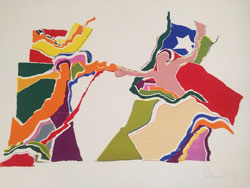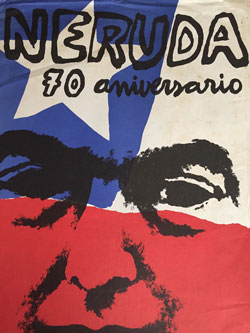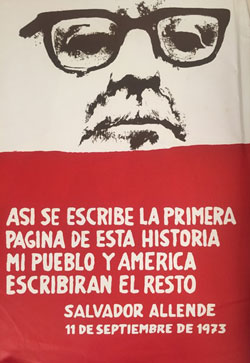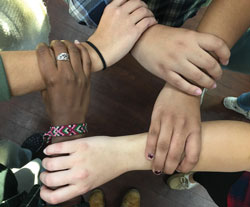In support of Hispanic Heritage Month, the University is hosting Memorias – Geography of a Decade: Chile 1973-1983 from Sept. 14 through Oct. 14 during the hours of 9 a.m. to 5 p.m. The exhibition is held in the Guggenheim Library room 101 and displays original serigraphs, posters, and photos of Chilean art.
Chilean writer and activist Gustavo Gac-Artigras will read excerpts from his most recent novel And We Were All Actors: A Century of Light and Shadow on Oct. 3 in Monmouth University Library room 102.
G. Gac-Artigras spent 40 years living under a strict military hand, and learned how to “distance [himself] from [his] memories in order to survive.” Although the captivity brought endless nightmares to the writer, they also taught him to be “tolerant and to listen to the other in order to be able to trust those who think differently.”
Priscilla Gac-Artigras, a professor of world languages and cultures, and wife of G. Gac-Artigas, is responsible for reviving these artworks at the University. As part of the Monmouth family, P. Gac-Artigras felt that the University was the perfect place to display the historical artifacts. “The new generations get to know those events from the past that make the human beings lose their humanity and act as enemies of their human fellows and learn a lesson from them. And the lesson is that ‘never again.’ Never again the holocaust, never again the dictatorships, never again the war, never again the massacres,” said P. Gac-Artigras.
Like these previously hidden artworks, G. Gac-Artigras is no stranger to captivity. The military coup of 1973 exiled G. Gac-Artigras along with 1,000,000 other Chileans. Living out his exile in Paris, the writer shared how the past affected him as he was forced to “get to know the limits of horror that marks your life, your dreams.”
In Paris, G. Gac-Artigras restarted his theater group, Théâtre de la Résistance- Chili, and later established Nuevo Teatro los Comediantes. Exile also brought him to meet his wife, who was pursuing her doctorate at the time.
This collection of art has been with the theater group throughout all their tours, travelling to France, Switzerland, Yugoslavia, and Tunisia. The art pieces were also showed in 18 other international theater festivals. Unfortunately, G. Gac-Artigras’s failed attempt at returning to Chile in 1984 kept these artifacts in the dark; however, they are now making their first appearance in the U.S. at the University.
 Senior Education major Danielle Ciaglia visited the exhibit and said “art like this needs to be shown especially in education. As an education major, I believe it’s important that art be integrated from other cultures to allow students to see different perspective as well as new ideas. It allows us to see a part of history as well as changes in our world.”
Senior Education major Danielle Ciaglia visited the exhibit and said “art like this needs to be shown especially in education. As an education major, I believe it’s important that art be integrated from other cultures to allow students to see different perspective as well as new ideas. It allows us to see a part of history as well as changes in our world.”
The exhibition features 52 works of art that communicate social, political, and cultural aspects of Latin America. The show is comprised of pieces from a number of painters such as Jose Balmes, Guillermo Núñez, Gracia Barrios, winner of three Chilean National Art awards, Joan Miró, Alejandro Marcos, Ernest Pignon-Ernest, Eduardo Berroeta, and Jack Ottaviano, and also features pictures by Gamma Agency Photojournalists, a famous press agency of the 70’s.
Various aspects of art, theater, and politics come together in the show to display a decade of Latin American history that, “marks how a particular historical moment impacts the evolution of the cultural expression of a nation,” said P. Gac-Artigras.
 P. Gac-Artigras asserts that the pieces have a “triple fold value,” conveying the socio-political movement while Chile was in exile, the creative expression of artists, and disparage dictatorial rule that pervaded Latin American countries. “When looking at these works, people should not only admire their artistic value, they should also ponder the significant value of the different kinds of artistic expressions within society as a means of solidarity and survival and most prominently, about what can they do to help prevent that events such as the ones that happened in Chile 43 years ago do not happen ever again. The exhibition embodies a holistic creative expression of the decade,” she said.
P. Gac-Artigras asserts that the pieces have a “triple fold value,” conveying the socio-political movement while Chile was in exile, the creative expression of artists, and disparage dictatorial rule that pervaded Latin American countries. “When looking at these works, people should not only admire their artistic value, they should also ponder the significant value of the different kinds of artistic expressions within society as a means of solidarity and survival and most prominently, about what can they do to help prevent that events such as the ones that happened in Chile 43 years ago do not happen ever again. The exhibition embodies a holistic creative expression of the decade,” she said.
As a writer, G. Gac-Artigras relays the importance of remembering Chilean history through text. Not only does it serve to preserve a country’s past, but to persuade its future. According to G. Gac-Artigras , the 70s and the 80s largely held the pursuit for societal equality. Many Latin American countries such as Argentina, Bolivia, Brazil, and Peru were seeking to establish a society full of equality and opportunity. “It was a moment in which we tried to conquer the universe armed with our dreams,” he said. His concerns are not only of the past, but for future generations as well.
“Remembering this period personally represents for me another humble intent of saying “never again” to the atrocities that were committed, so that a better future becomes a reality for you and your generation,” G. Gac-Artigras said.
In the wake of his new novel, G. Gac-Artigras hopes to produce even more inspirational and informative works. The writer is currently working on his next piece and said, “I am dreaming, doing research, taking notes, outlining characters, taking more notes, notes that, for sure, I will forget when the beautiful moment arrives in which I will see my characters escaping from my mind to the page and begin walking on their own through unknown paths.”
P. Gac-Artigras said her husband’s writing has the power to evoke wonder and understanding. “He makes people feel, see, smell, hear what lies between and behind the lines so they connect the dots to complete the sense of his words and enrich the story by reconstructing it with the input of their own particular experiences, feelings and thinking,” she commented.
Karen Bright, a professor of art and design, vouched for the inspiration and beauty of the art. “The work is of an extremely high caliber, conveying a universal understanding of pain and suffering that is unnervingly relevant—even to this day,” she said. “My students and I spent an exceptional hour exploring the meaning and importance of this collection. What a meaningful way to celebrate Hispanic Heritage Month and the start of the academic year.
PHOTOS COURTESY of Priscilla Gac-Artigras



